|
Top 10 Best Alfred Hitchock Movies.
Alfred Hitchcock's (1899-1980) own perception was that his best movies were
the ones that have been embraced by the audience.
Although in the Top 10 list
below you can find some of his greatest box-office successes, more criteria
have been included such as the acting, script, influence and innovation. Well,
here we go:
|
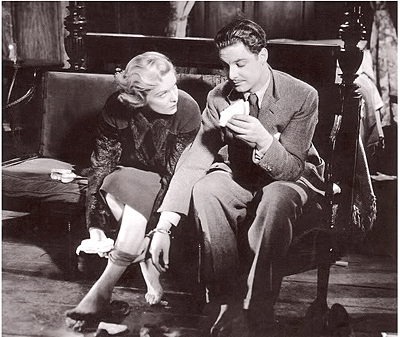
|
10) The 39 Steps (1935)
One of Hitchcock finest movies he directed in the U.K. before he left for
the U.S. In the very tightly plotted "innocent man on the run" -tale
(Hitchcock used this format also in Young and Innocent, Sabotage
and North by Northwest), the protagonist Richard Hannay >
(Robert
Donat) gets involved in a murder mystery in which he's unjustly
the prime suspect. From that moment he's haunted by the police and the real
culprits and therefore is subjected to some suspenseful and hilarious events.
Besides the nicely timed plot twists, the performances from Donat and
Madeleine Carroll (the resentful heroine) really standout.
|
|
Madeleine Carroll and Robert Donat in The 39 Steps
|
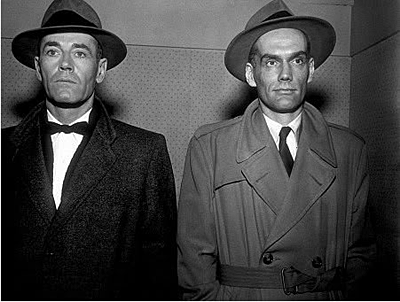 |
9) The Wrong Man (1956)
> The Wrong Man
probably Hitchcock's least characteristic movie.
Not a playful and suspenseful thriller but a grim urban tale, presented in
grainy B & W camerawork, about the wrongfully accused (robbery) jazz
musician Manny Balestrero (Henry Fonda). The movie is a rarity in Hitchcock's
oeuvre with its customary sense of mischief entirely absent. Hitchcock and his
film crew went to extraordinary lengths to tell Balestrero's story accurately.
Although Hitch didn't feel that strong about it, the result is a stark and
chilling film with impressive performances by Fonda and Vera Miles, as his
feverish and anguishing looking wife.
|
|
Henry Fonda (l.) in a line-up
|
 |
8) Shadow of a Doubt (1942)
Without a doubt Hitchcock's most personal film (and one of his favorites).
>
Joseph
Cotten plays the beloved uncle Charlie, who's adored by his niece
(Teresa Wright) but turns out to be a murderer. He's trailed by the police and
seeks refuge with the small-town family of his sister. The focus is on the
gradual realisation of the niece that her uncle has "two faces" but
on a subliminal level it also is a satyrical analysis of middle-American life.
Together with Psycho, this is the only Hitchcock picture in which the central
figure is a villain.
|
| Affiche for Shadow of a Doubt
|
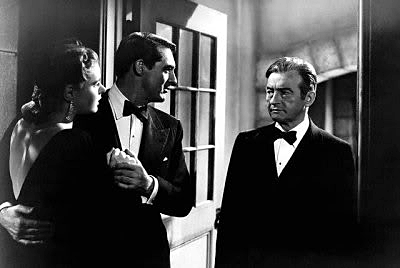 |
7) Notorious (1946)
The espionage plot in Notorious, of Nazis seeking refuge in
South-America is merely a MacGuffin*. The real focus is on the sadistic
relationship between a US agent T.R. Devlin (Cary Grant), the alcoholic Alicia
Huberman (Ingrid Bergman) and the Nazi with a mother complex Alexander
Sebastian > (Claude Rains)
who's trying to poison her. In his famous interview with Hitchcock Francois
Truffaut remarked: "...in Notorious you have at once a maximum of stylization
and a maximum of simplicity". It remains one of his finest movies of
the Forties with top-notch performances.
|
|
Ingrid Bergman (l.), Cary Grant (m.) and Claude Rains (r.)
|
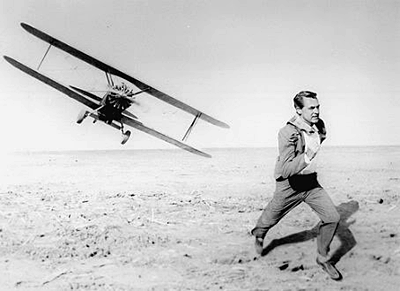 |
6) North by Northwest (1959)
> North by Northwest
has a masterful blend of nightmarish suspense and refined comedy. Cary Grant
is Roger Thornhill, a nonchalant advertising executive who gets submerged in a
web of intrigue. The rapid pace in which the events take place (especially in
the first third of the picture) was unprecedented at that time. The movie is
filled with memorable scenes, like the thrilling airplane sequence in the
cornfield or the iconic climax on Mount Rushmore, and magnificent supporting
acts from Leo G. Caroll, Martin Landau and James Mason as the charming
villain.
|
|
Cary Grant in North by Northwest
|
 |
5) Frenzy (1972)
Hitchcock's return to the UK (London, Convent Garden) and the epitomization
of his "wrong man" plotting. In one of the interviews concerning Frenzy
he said: "If you choose Cary Grant in the leading part everyone knows
he's not the villain". That's why he chose the unfamiliar theatre
actors > Jon Finch
and Barry Foster in the leading parts. Frenzy is full of wonderful set
pieces like the grisly corpse wrestling match on a truck loaded with potatoes,
masterfully edited murder scenes and great acting with a very amusing role of
Alec Mc Gowen as the inspector who's not only investigating the "Necktie
Murders" but also his wive's "cooking". With this movie
Hitchcock proofed, after a rather dull and failed series of pictures he made
in the Sixties, that he was still able to appeal to a modern audience. It's
nasty, humorous, manipulative and it's the last great work of the Master of
Suspense.
|
|
Affiche for Frenzy
|
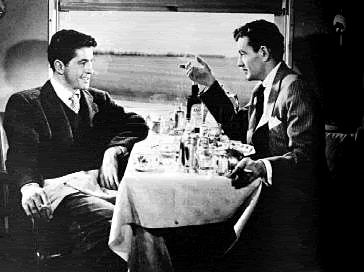
|
4) Strangers on a Train (1951)
Based on a novel by
Patricia Highsmith about two complete strangers who have a unilateral
exchange of murders. >
Robert Walker
(excellent) is the dandy-esque psychopath Bruno Antony who tries to
entice the star tennis-player Guy Haines (Farley Granger, Hitchcock
initially wanted William Holden) into a murder swap. Strangers on a Train
is as tightly plotted as one possibly could get and is rightfully called
a Hitchcock classic despite some minor flaws (Dull performances by
Granger and Ruth Roman and some illogical plot twists.) it's a very
clever, funny and atmospheric movie. Besides the dominating perfromance
of Walker as the suave and charismatic villain there is a very amusing
supporting role by Patricia Hitchcock (Hitchcock's daughter) as the
indiscreet but alluring Barbara and by Marion Lorne who plays the
delirious mother of Bruno.
|
|
Farley Granger (l.) and Robert Walker
|
 |
3) Rear Window (1954)
Hitchcock was mainly interested in doing this movie because of the
technical challenge in doing a purely cinematic picture but along the way
while working on the script more importance was attached to the story itself.
The idea of an immobilized man Jeff Jeffries (James Stewart) looking out of
his window showing what he sees and then how he reacts. He called it the
purest expression of a cinematic idea. The movie reveals every kind of human
behavior in a small universe portrayed in a group of little stories.
Hitchcock's movie > Rear Window
has a wonderfully created (studio)
set, a script that is larded with countless memorable lines and a magnificent
ensemble cast with Grace Kelly as Jeffries' girl-friend, who's more beautiful
than ever, Thelma Ritter as the sarcastic nurse and Raymond Burr as the
malevolent salesman.
|
|
Grace Kelly and James Stewart in Rear Window
|
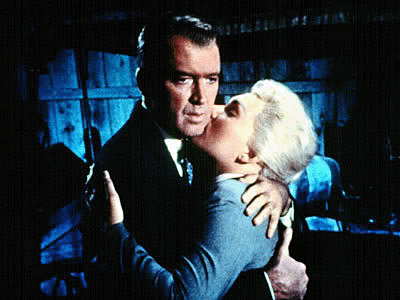
James Stewart and Kim Novak in Vertigo
|
2) Vertigo (1958)
When police detective Scottie Ferguson (James Stewart) resigns after having
a traumatic experience (due to his vertigo - fear of hights) in which he lost
a colleague after chasing a suspect on a rooftop, an old friend hires him as a
private detective to trail his beautiful but suicidal wife Madeleine >
(Kim
Novak). During this followings he slowly falls in love with her and
after she dies he becomes obsessed, seeing her everywhere. In the interview
with Truffaut Hitchcock explained: "I was intrigued by the hero's attempts to
re-create the image of a dead woman through another one who's alive".
Vertigo is Hithcock's bleakest and most enigmatic picture (numerous
books have been published concerning the various contexts, themes and subjects
treated in the movie) with an excellent cast (Novak is sublime in a double
role). It is also famous for Hitchcock's 'Dolly out/Zoom in' technique which
is used in countless movies afterwards like Spielberg's Jaws (1975)
|
|

Anthony Perkins in Psycho
|
1)
Psycho (1960)
|
| Despite
its minor flaws (the supporting role of Simon Oakland as Dr.
Fred Richmond who gives a nonsensical explanation at the end) >
Psycho
is Hitchcock's best and without a doubt his most influential
picture. Famous (or infamous) for eliminating its heroine (Janet
Leigh) after two reels in the perfectly edited shower sequence
and groundbreaking in constantly shifting the audience's
expectations and switching their loyalties. The movie was
adapted from Robert Bloch's novel Psycho which was inspired by
the serial killer Ed Gein who had a mother complex. Hitchcock
was especially attracted to the book because he liked to idea of
the "out of the blue" murder in the shower. For
Anthony Perkins the movie was his breakthrough but unfortunately
he was so convincing in his role of the estranged psychopath
Norman Bates that it ruined his career. The movie was Hithcock's
biggest success and was made on a modest budget of only
$800.000,- and spawned four sequels (Psycho III directed by
Anthony Perkins). To name all the movies and books that are
tributary to Psycho
is a hopeless mission but some of the more important are Repulsion (Roman
Polanski, 1965), The Texas Chainsaw Massacre (Tobe
hooper, 1974), Halloween
(John Carpenter, 1978), the novels Red Dragon and Silence of the
Lambs by Thomas Harris and American Psycho by Brett Easton
Ellis. In 1998 Gus van Sant made a faithful shot-for-shot remake
of Hitchock's masterpiece with Vince Vaughn as Norman Bates and
Anne Heche as Marion Crane.
|
*MacGuffin: Hitchcock used this word to
describe an item or objective upon which the plot hangs that is immaterial to
the actual story.
What it actually is is
unimportant, because it's merely the catalyst that sets the drama in
motion.
Click here for another article on >
Hitchock
or here for other >
movie
subjects
|
|